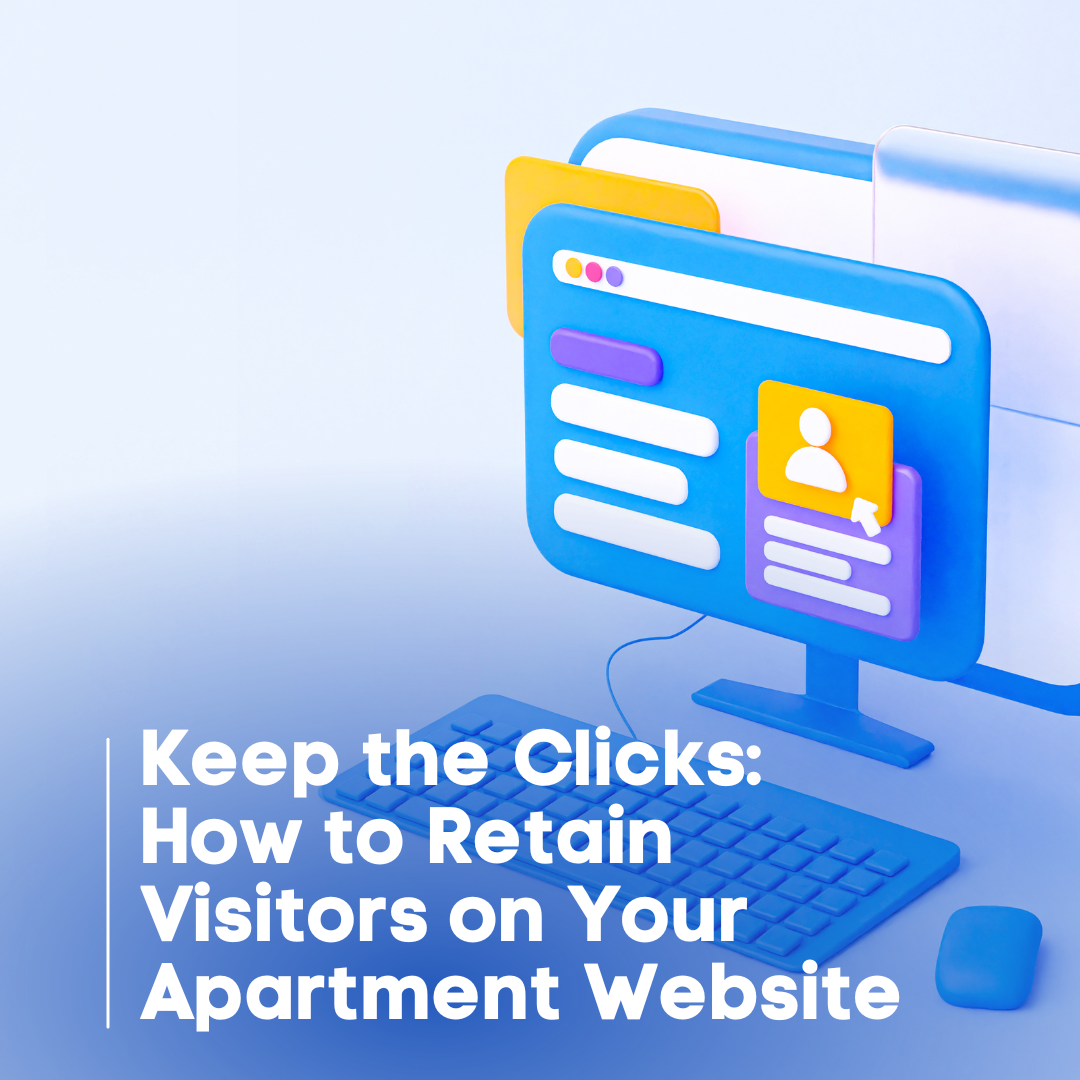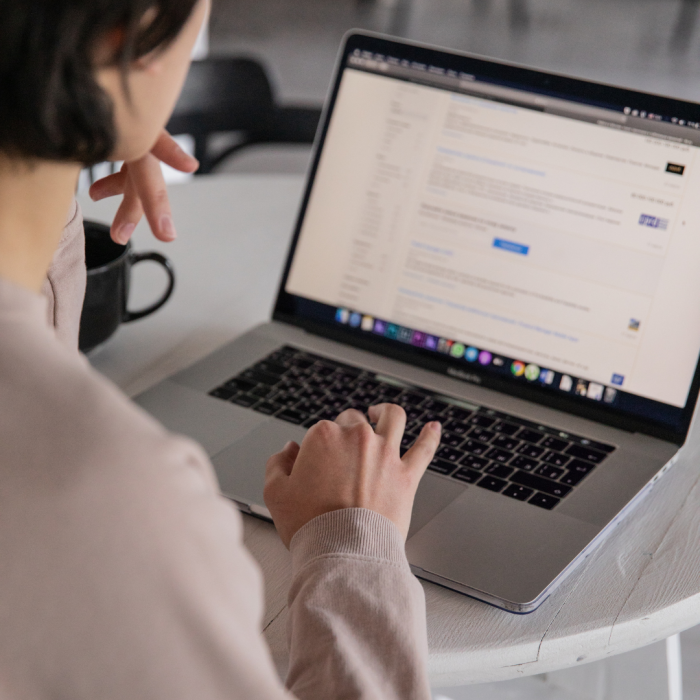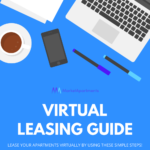
Create the best apartment website by learning more about your target audience! Understanding why visitors leave your apartment website is crucial for the success of your online presence. If you don’t solve this problem, then you will not keep anyone on your website long enough to move through scheduling a tour or signing a lease. In an era where the majority of property searches begin on the internet, your website serves as the first impression potential tenants have of your apartments.
First impressions are everything, and you don’t want your website to be the end of the renter experience. Identifying the reasons behind visitor exits can help you refine your website, enhance user experience, and ultimately convert more leads into tenants.
Uncover the pain points and start addressing them, so you can increase your website’s effectiveness in attracting and retaining prospective renters. This apartment marketing approach will lead you to higher occupancy rates and improved profitability. In this digital age, knowing why visitors depart from your apartment website is the key to staying competitive and thriving in the real estate market.
Identifying the Last Stop – Where Potential Renters Drop Off
The first step is to figure out why people are leaving your website, and where they’re dropping off at. Analyzing exit pages on apartment websites is a valuable exercise to gain insights into user behavior and inform website improvements. 70% of users decide within the first 5 minutes of website browsing whether they will stay or leave. Understanding these initial interactions is crucial. Exit pages are defined as the final pages users visit before leaving a website. When you understand further why potential renters exit at specific points of the website, you can then optimize the user experience and potentially increase conversions.
By looking at your website’s exit pages, you can identify potential pain points or obstacles that are causing people to leave the page. Common issues may include slow-loading pages, unclear or inadequate information on rental listings, confusing navigation, or frustrating user flows. Identifying these issues is the first step in making informed improvements to your website.
Ensure that you have the proper tools to know where someone leaves your apartment website. To track and understand this data, you can use website analytics tools such as Google Analytics, which provides detailed reports on user behavior, including exit pages. This tool allows you to monitor where users are exiting, how long they stay on specific pages, and what paths they take before leaving.
Other analytics tools like Hotjar and Crazy Egg offer heatmaps and session recordings, enabling you to visualize user interactions and better understand their experience. You can also work with apartment SEO professionals who can help you uncover what’s really happening on your site.

Mobile Optimization: Catering to the On-the-Go Renter
It’s no secret that catering to your mobile audience is the right approach!
80% of users use mobile devices to search for apartments. Mobile optimization is crucial for any website, given the increasing reliance on smartphones for property searches. Plus, people are constantly on their phones and often use it as their main device when searching for anything. Here are some best practices for mobile optimization in the context of apartment hunting:
- Responsive Design: Implement a website design that adapts seamlessly to various screen sizes and orientations. This ensures that your website looks and functions well on smartphones, tablets, and desktops.
- Fast Load Times: Mobile users are often on the go and have less patience for slow-loading websites. Optimize your website for speed by compressing images, minifying code, and leveraging browser caching. This will enhance user experience and decrease bounce rates.
- Streamlined Navigation: Simplify your website’s navigation for touchscreen devices. Use clear and easy-to-tap buttons, intuitive menus, and minimal scrolling to ensure users can easily find and access the information they need.
- Mobile-Friendly Search: Make your search functionality complete with options like location-based searches, filters, and a user-friendly interface. Allow users to save and revisit their searches for added convenience.
- Interactive Maps: Incorporate interactive maps with property listings, allowing users to explore neighborhoods and property locations easily. This feature can be particularly useful for apartment hunters unfamiliar with the area.
- Optimized Forms: Mobile users should be able to complete inquiry forms and applications without frustration. Create sequences with fewer fields and auto-correction options to improve the user experience.
- High-Quality Visuals: Utilize professional images and videos to showcase your apartments. Mobile users rely heavily on visuals, so make sure your media is clear, engaging, and optimized for quick loading.
- Mobile Analytics: Regularly monitor mobile-specific analytics to gain insights into user behavior. Identify which pages receive the most visits, where users drop off, and what features they engage with most. Use this data to make informed improvements.
Mobile user behavior in apartment hunting is marked by impulsive decisions and on-the-go research. Your future renters will likely often rely on mobile devices for quick property searches, and they appreciate responsive designs that get them to their destination. Interactive elements like chatbots and FAQs can significantly retain visitors on your website, providing them with instant answers and keeping them engaged.
Websites with interactive elements (e.g., virtual tours) see a 40% higher engagement rate than those without.
Being able to access photos, location details, pricing, and contact information easily is essential. Most mobile users also have a short attention span, and refining the mobile design will capture them more easily and for longer.
Beyond Keywords: How Local Search Affects Apartment Visibility
Local SEO is a digital apartment marketing strategy focused on improving a website’s visibility in local search results, particularly in search engines like Google. It is highly relevant to apartment websites as it helps potential renters find and choose apartments in specific locations, making it a powerful tool for attracting local traffic. Here are some key principles and steps to optimize for local search on apartment websites:
- Optimize Google My Business (GMB) Listings:
Claim or create a Google My Business listing for each apartment complex or property you manage. Ensure that your GMB profile is complete and accurate with essential information such as name, address, phone number, website, and business hours.
- Local Keywords: Research and incorporate local keywords into your website content. Websites offering personalized content based on user behavior see a 20% increase in engagement. This includes terms like “apartments in [city/neighborhood],” “rental properties near [landmark],” or “apartments for rent in [city].”
Create unique, location-specific landing pages for each property or neighborhood you serve.
- On-Page SEO: Optimize title tags, meta descriptions, and headers with local keywords.
Include your location in your content and descriptions to make it clear to search engines that you serve a specific area. Regularly update your content to keep information current, which can lead to a 15% increase in returning visitors.
- Local Link Building: Build high-quality backlinks from local sources, such as local business directories, local news websites, or neighborhood organizations.
Encourage user-generated content like reviews and testimonials from local renters.
- Consistent NAP Citations:
Ensure that your business name, address, and phone number (NAP) are consistent across your website, GMB listing, and other online directories. Inconsistent information can harm your local SEO.
Encourage satisfied renters to leave reviews on your Google My Business page and other review platforms. Respond to reviews, whether positive or negative, to show your commitment to customer satisfaction.
- Local Schema Markup:
Implement local schema markup on your website to provide search engines with structured data about your business, location, and offerings.
- Geotagging Images:
Geotag images on your website to provide additional location data to search engines.
- Monitor and Analyze:
Regularly monitor your local SEO efforts using tools like Google Analytics and Google Search Console to track your website’s performance in local search results. Make necessary adjustments based on the data.
Local SEO for apartment websites is vital in helping potential renters find your properties when they search for apartments in specific areas. By following these principles and steps, you can improve your website’s local search visibility, attract more local traffic, and increase the chances of converting visitors into renters.

Color Schemes: Setting the Emotional Tone for Your Website
Color psychology plays a significant role in website design, impacting user emotions, perceptions, and behavior. When applied effectively, it can enhance the overall user experience and promote desired actions, such as in the context of apartment websites. Here’s an overview of color psychology as it applies to website design and examples of effective color schemes for various types of apartment communities:
Understanding Color Psychology in Website Design:
Blue: Often associated with trust and serenity, blue is a common choice for apartment websites, creating a sense of security and reliability.
Green: Evokes feelings of nature, health, and renewal. Green can be suitable for eco-friendly or sustainable apartment communities.
Yellow: Associated with positivity and energy, yellow can work well for apartment communities targeting young and vibrant renters.
Neutral Tones (e.g., beige, gray): Create a sense of sophistication and timelessness, making them suitable for luxury apartment websites.
Red: This bold color can be used sparingly to draw attention to specific elements, such as calls to action or special offers.
Effective Color Schemes for Apartment Communities:
- Luxury Apartments:
Primary Color: Deep, rich shades of navy blue or charcoal gray.
Accent Colors: Gold, silver, or deep red for a touch of opulence.
Example: Navy blue as the dominant color, with gold accents, exuding a sense of elegance and luxury.
Eco-Friendly Apartments:
Primary Color: Shades of green, from earthy to fresh.
Accent Colors: Soft blues and neutral tones to convey a connection to nature.
Example: A fresh, light green as the primary color with accents of soft blue, creating a harmonious, eco-friendly feel.
- Student Apartments:
Primary Color: Energetic and youthful shades like bright blue, yellow, or red.
Accent Colors: White or light gray for balance.
Example: Vibrant blue as the primary color with white accents, appealing to a young, dynamic audience.
Family-Friendly Apartments:
Primary Color: Calming and family-oriented shades of soft blue or warm beige.
Accent Colors: Light green or soft yellow to evoke a sense of safety and comfort.
Example: Soft blue as the primary color, with accents of light green, creating a welcoming and family-friendly atmosphere.
It’s essential to consider your target audience and the message you want to convey when selecting a color scheme for your apartment community website. A well-thought-out color scheme can set the tone, establish trust, and influence the emotional response of visitors, ultimately helping in the conversion of apartment website visitors into prospective renters.
Speed Optimization: Enhancing Load Times to Keep Visitors Engaged
Slow loading times are a primary reason for increased bounce rates; visitors expect quick access to information. Load times have a profound impact on user retention when it comes to apartment websites. In today’s fast-paced online environment, users expect instant access to information, and even a slight delay can result in frustration and abandonment of the site.
One essential factor in optimizing load times is image optimization. Large, unoptimized images can significantly slow down page loading, and therefore, it’s imperative to compress and resize images to reduce file sizes while maintaining quality.
Additionally, leveraging browser caching is a vital technique to improve load times. By storing certain website elements in a user’s browser cache, subsequent visits become much faster, as the browser doesn’t need to re-download the same resources. Furthermore, minimizing HTTP requests is crucial. Each request made to the server for resources like scripts, stylesheets, or images adds to the load time.
Reducing the number of requests by combining files or using asynchronous loading techniques can substantially enhance the user experience and increase the likelihood of visitors staying on your apartment website. In today’s competitive online rental market, load times and these optimization strategies are pivotal in retaining potential tenants and ensuring a positive user experience.
Intuitive Navigation: Simplifying the Path to Information
Complex or confusing navigation structures can frustrate users, leading them to abandon the search. Crafting a user-friendly navigation menu is a fundamental aspect of web design that can significantly impact the overall user experience.
To begin, it’s essential to create a clear and intuitive menu structure that reflects the hierarchy of your content and services. A straightforward and organized menu makes it easier for visitors to find what they’re looking for. Breadcrumb trails are another valuable tool for aiding navigation, as they provide users with a contextual path back to where they started, especially on deep or complex websites.
This feature helps users maintain a sense of orientation and simplifies their journeys through your site. Moreover, simplifying user flows and reducing unnecessary clicks are important. Minimizing the steps required to access information or complete tasks ensures that users can quickly and easily find the content they seek.
By implementing these principles, you can create a user-friendly and efficient navigation system that enhances the accessibility of information and improves the overall usability of your website. Websites that comply with WCAG 2.1 accessibility guidelines see an average 20% increase in time spent by users with accessibility needs. Enhancing the visitor experience with user-friendly features like quick contact forms and real-time availability updates can significantly improve satisfaction and engagement rates.

Targeted Content: Aligning with Prospective Renters’ Needs
Apartment content that doesn’t resonate with the target audience or doesn’t address their needs can lead to disinterest and site abandonment. Understanding your audience is the cornerstone of effective marketing and communication in the apartment rental industry. To connect with potential renters, it’s essential to create detailed renter personas that represent your target demographic accurately. Implementing visitor retention strategies, such as offering virtual tours and detailed neighborhood guides, can encourage users to explore your website more thoroughly.
These personas help you delve deep into the preferences, behaviors, and pain points of your audience. Tailoring your website content, listings, and messaging to match these personas enables you to speak directly to your prospective tenants’ needs and desires.
This level of personalization not only enhances the user experience but also fosters trust and a sense of relatability, making it more likely for visitors to engage with your content and ultimately choose your apartments. By focusing on engagement with your website’s content, such as interactive floor plans or virtual tours, you can significantly enhance the user experience and keep potential renters interested.
By knowing your audience, developing renter personas, and customizing your approach to meet their preferences and address their pain points, you can effectively reach and resonate with the right tenants, increasing your chances of successfully converting leads into renters.
Social Proof and Testimonials: Building Trust and Credibility
Lack of social proof such as testimonials, reviews, or ratings can make a site seem less trustworthy, leading to higher bounce rates. In the competitive world of apartment rentals, trust is a currency of utmost importance. To build trust with potential tenants, it’s crucial to include genuine resident testimonials, industry certifications, and ratings on your website. Genuine resident testimonials provide a firsthand account of the living experience, offering valuable insights into the quality of your apartments and the overall satisfaction of your tenants.
These testimonials lend authenticity and credibility to your offerings, giving prospective renters confidence in their decisions. Industry certifications and ratings from reputable organizations serve as external endorsements of your property’s quality and professionalism. They signal that your apartments meet certain standards and adhere to best practices, further bolstering your credibility.
In a market where renters have numerous options, these elements combine to create a compelling narrative of trustworthiness, helping you stand out and reassure potential tenants that they are making a wise choice by choosing your apartments as their future homes. Utilizing social media platforms and email newsletters for marketing your content effectively broadens your reach and draws more potential renters to your website.
Get a better apartment website today!
In conclusion, understanding why visitors leave your apartment website is crucial for optimizing its performance and increasing your chances of turning those visitors into tenants. From slow load times to a confusing navigation menu or irrelevant content, identifying the pain points is the first step in making meaningful improvements.
By addressing these issues and tailoring your website to meet the preferences and needs of your target audience, you can keep users engaged, boost your website’s effectiveness, and ultimately see a positive impact on your occupancy rates and business success. A robust retention strategy, incorporating elements like personalized recommendations and follow-up emails, can turn one-time website visitors into long-term prospects.
As the digital landscape continues to evolve, staying attuned to the reasons behind visitor exits is not just a best practice but a necessity for thriving in the competitive world of apartment rentals.
Categorised in: Apartment Marketing
This post was written by Isabella Housel
Isabella Housel is a passionate and versatile professional writer with a deep love for words and a commitment to crafting compelling content that engages, informs, and inspires. With many years of experience in the industry, she has honed her skills across various genres, from creative storytelling to informative articles and technical documentation.





